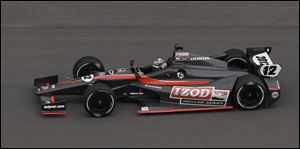
Test drivers like feel of 2012’s new IndyCars
10/5/2011
Dan Wheldon test drives the 2012 IndyCar at the Indianapolis Motor Speedway in Indianapolis last month.
INDIANAPOLIS — Scott Dixon likes the sound and safety features of the new IndyCars.
Dan Wheldon prefers the way they handle.
Will Power is all for the turbochargers.
Each of the three drivers who have been testing the 2012 cars over the past week has favorite aspects in next year’s model, but they agree on one thing — the new cars will be a welcome change for drivers and fans.
“We’ve got a totally new package of technology, it’s closer to what people use in their cars,” Dixon said after Tuesday’s session at Mid-Ohio. “It’s a lot lighter, it’s more nimble and to me, it’s more up-to-date.”
There are many differences between this season’s version and next year’s.
Turbochargers return to the series for the first time since the 1990s, giving drivers a more powerful and efficient V6 engine.
There will be less noise at races, and track records may no longer be just a thing of the past at Indianapolis, the series’ highest-profile venue.
Fans will get to see competition among engine manufacturers. Chevrolet, Honda and Lotus are all on board for next season, and teams have begun deciding which one they’ll choose.
And safety will be upgraded, too. In fact, Dixon, a two-time IndyCar champ and the 2008 Indy 500 winner for Target Chip Ganassi, believes the new car is built better to handle crashes — no matter what speeds drivers achieve.
“The seating is a big safety improvement,” said Dixon, a New Zealand native. “There’s 3 inches of foam surrounding the cockpit before you even put the seat in, so things like what happened with Justin Wilson at Mid-Ohio earlier this year, I think, will be eliminated and you won’t have those big forces being pushed through the drivers.”
Wilson broke a vertebra in his back when he spun off the course and hit a bump between Turns 1 and 2 in August.
Dixon is all for the changes, and he’s not alone.
Power, second in points heading into next weekend’s season finale at Las Vegas, was scheduled to test with Dixon on Tuesday and Wednesday in Ohio. Dixon ran the Honda engine, Power took the Chevy.
Bad weather shortened Tuesday’s session and organizers are not allowing the drivers to discuss how fast they’re running, though the drivers say these sessions are more about working out bugs than going fast.
Still, they ran long enough to get a feel for what will work.
“I like the turbochargers,” said Power, an Aussie who drives for Team Penske. “When we ran them in Champ Car, you could really tell how much force you had on them and the sound is really cool.”
Nobody knows these cars better than Wheldon, the two-time Indy winner and 2005 points champ.
Without a full-time ride this season, series officials hired the Englishman to do most of the tests. He’s run on Indianapolis’ road course, last week spent three days as the first driver on Indy’s historic 2.5-mile oval in the new car and is convinced series officials and engineers got this car right.
“It feels good. It feels like you’d expect it to react and it feels like a race car around there,” Wheldon said. “To be quick, you’ll have to get the car down to the white line and up to the apex in the corner, but what I really like is how reactive it is.”
The good marks do not mean the transition will go smoothly for everyone.
The Honda engines could have an early edge because they’ve been the only power plant in IndyCar since 2006. Ganassi’s team, which has won the last three points titles and is in position for a fourth straight season championship, and A.J. Foyt Enterprises already have announced they’re sticking with Honda.
Team Penske and Andretti Autosport have aligned themselves with Chevy, which returns to the circuit for the first time since 2005.
The biggest question is engine reliability, an issue that Honda has mostly eliminated in recent years.
While the test drivers have found nothing to raise suspicions, getting a new product is always a bit of a concern.
“I think there will be quite a lot of testing and whoever it is will make sure it’s reliable,” Wheldon said last week. “I think that’s what we achieved. It definitely requires a slightly different technique with the turbocharged engine. What’s great about this is it will level the playing field.”
That may not be good news for the three teams that have dominated IndyCar racing over the past decade — Andretti, Ganassi and Penske.
But after the Oct. 16 season-finale at Las Vegas, most teams will spending the offseason fine-tuning the new cars and finding ways to win races.
“Drivability will be harder, so that will make drivers and teams work a lot harder to set up the car,” Dixon said. “But if you miss it, you’re going to miss it by more.”